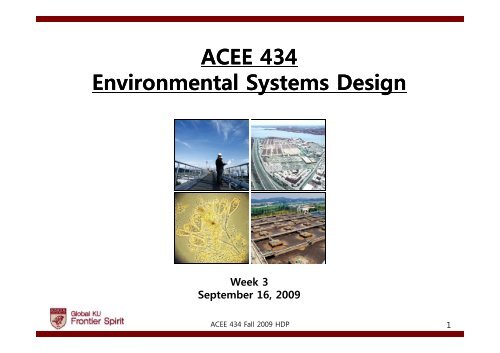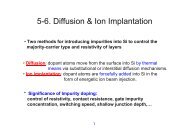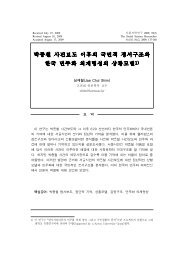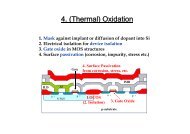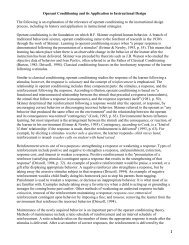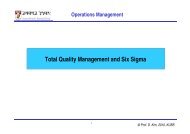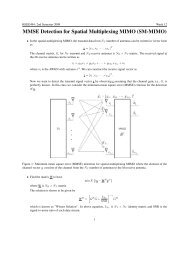ACEE 434 Environmental Systems Design - Korea University
ACEE 434 Environmental Systems Design - Korea University
ACEE 434 Environmental Systems Design - Korea University
You also want an ePaper? Increase the reach of your titles
YUMPU automatically turns print PDFs into web optimized ePapers that Google loves.
<strong>ACEE</strong> <strong>434</strong><br />
<strong>Environmental</strong> <strong>Systems</strong> <strong>Design</strong><br />
Week 3<br />
September 16, 2009<br />
<strong>ACEE</strong> <strong>434</strong> Fall 2009 HDP 1
Overview<br />
Guri WWTP<br />
<strong>ACEE</strong> <strong>434</strong> Fall 2009 HDP 2
Screen, Grit Removal<br />
Influent<br />
Primary Clarifiers<br />
Aeration Tanks<br />
Dewatering<br />
Facilities<br />
Effluent<br />
Secondary<br />
Clarifiers<br />
Ozone<br />
Disinfection<br />
Anaerobic<br />
Digesters<br />
Satellite image obtained from NAVER<br />
<strong>ACEE</strong> <strong>434</strong> Fall 2009 HDP 3
Pretreatments<br />
Screen<br />
Grit removal chamber<br />
<strong>ACEE</strong> <strong>434</strong> Fall 2009 HDP 4
Primary Treatments<br />
Primary clarifier<br />
Buoyant solids<br />
<strong>ACEE</strong> <strong>434</strong> Fall 2009 HDP 5
Secondary Treatments<br />
Aeration tank<br />
Secondary clarifier<br />
<strong>ACEE</strong> <strong>434</strong> Fall 2009 HDP 6
Advanced Treatments<br />
Ozone disifection<br />
<strong>ACEE</strong> <strong>434</strong> Fall 2009 HDP 7
Wastewater<br />
Constituents<br />
• Physical characteristics<br />
• Inorganic characteristics<br />
ti<br />
• Organic characteristics<br />
• Biological characteristics<br />
http://www.co.allen.oh.us/san/htmlPPT/american2/images/16.jpg<br />
<strong>ACEE</strong> <strong>434</strong> Fall 2009 HDP 8
Physical Constituents<br />
• Solids<br />
• Particle size distribution<br />
• Turbidity<br />
• Color<br />
• Transmittance<br />
• Temperature<br />
• Conductivity<br />
• Density<br />
• Specific gravity<br />
• Specific weight<br />
<strong>ACEE</strong> <strong>434</strong> Fall 2009 HDP 9
Solids<br />
105 o C<br />
105 o C<br />
Imhoff cone<br />
MetCalf and Eddy Figure 2-5<br />
500 o C Filter unit<br />
MetCalf and Eddy Figure 2-3<br />
Interrelationships of solids found in water and<br />
wastewater. In much of the water quality literature, the<br />
solids passing through the filter are called dissolved<br />
solids.<br />
Aluminum dish<br />
Glass fiber<br />
filter<br />
MetCalf and Eddy Figure 2-4<br />
<strong>ACEE</strong> <strong>434</strong> Fall 2009 HDP 10
Size Range<br />
0.45 -2.0μm: filter size for TSS determination<br />
MetCalf and Eddy Figure 2-7<br />
Size ranges of organic<br />
contaminants in wastewater and<br />
size separation and measurement<br />
techniques used for their<br />
quantification<br />
<strong>ACEE</strong> <strong>434</strong> Fall 2009 HDP 11
Example 2-4<br />
Analysis of solids data<br />
Sample size = 50 mL<br />
• Tare mass of evaporation dish = 53.5433 g<br />
• Mass of evaporating dish plus residue after evaporation at 105 o C = 53.5794 g<br />
• Mass of evaporating dish plus reside after ignition at 550 o C = 53.5625 g<br />
• Tare mass of Whatman GF/C filter after drying at 105 o C = 1.5433 g<br />
• Mass of Whatman GF/C filter and reside after drying at 105 o C = 1.5554 g<br />
• Mass of Whatman GF/C and residue after ignition at 550 o C = 1.5476 g<br />
Determine total solids (TS), total volatile solids (TVS), total suspended solids<br />
(TSS), volatile suspended solids (VSS), total dissolved solids (TDS), and volatile<br />
dissolved solids (VDS), respectively.<br />
MetCalf and Eddy Example 2-4<br />
Analysis of solids data<br />
<strong>ACEE</strong> <strong>434</strong> Fall 2009 HDP 12
Temperature<br />
• Very important t parameter because of its effect on chemical reactions and<br />
reaction rates, aquatic life, and the suitability of the water for beneficial uses.<br />
• Most important in wastewater treatment<br />
- Dissolve oxygen solubility ↓ as temperature ↑<br />
- Biological activity ↑ as temperature ↑ (optimum range 25-35 o C)<br />
- Chemical activity ↑ as temperature ↑<br />
<strong>ACEE</strong> <strong>434</strong> Fall 2009 HDP 13
Temperature<br />
• Effects on reaction rates (van’t Hoff-Arrhenius relationship)<br />
d(ln<br />
k)<br />
dT<br />
E<br />
= RT<br />
2<br />
dT<br />
k2 E(<br />
T2<br />
−T1<br />
) E<br />
ln = =<br />
( T<br />
2<br />
−T<br />
1<br />
)<br />
k<br />
RT T<br />
RT T<br />
1 1 2<br />
1T2<br />
C<br />
k<br />
ln 2 =<br />
C<br />
(<br />
T<br />
2<br />
−T<br />
1<br />
)<br />
k<br />
1<br />
k<br />
k<br />
k 1<br />
k<br />
k<br />
C ( T 2 − T )<br />
= e e C = θ<br />
2 1<br />
k 1<br />
= θ<br />
( T 2 −T<br />
)<br />
2 1<br />
<strong>ACEE</strong> <strong>434</strong> Fall 2009 HDP 14
Temperature<br />
The effect of temperature t on the maximum growth rate of Nitrosomonas<br />
ˆ μ<br />
μ N<br />
=<br />
0.47e<br />
0.098( T −15)<br />
wth<br />
Maxi imum spe ecific gro<br />
rate (d day-1)<br />
16<br />
14<br />
12<br />
10<br />
8<br />
6<br />
4<br />
2<br />
0<br />
0 10 20 30 40 50<br />
Temperature (oC)<br />
<strong>ACEE</strong> <strong>434</strong> Fall 2009 HDP 15
Inorganic Constituents<br />
•pH<br />
• Nitrogen<br />
• Phosphorus<br />
• Alkalinity<br />
• Chlorides<br />
•Sulfur<br />
• Other inorganic constitutents<br />
• Gases<br />
• Odors<br />
<strong>ACEE</strong> <strong>434</strong> Fall 2009 HDP 16
pH<br />
• The concentration range suitable for the existence of most biological life is<br />
quite narrow and critical (typically 6 to 9).<br />
+<br />
pH = −logl<br />
10 [<br />
H<br />
]<br />
O H 2<br />
↔<br />
H<br />
+ +<br />
OH<br />
−<br />
[ H<br />
][ OH<br />
H O<br />
+<br />
2<br />
−<br />
]<br />
=<br />
K<br />
http://www.techneusa.com/ph/3510.jpg<br />
[ H<br />
+<br />
][ OH<br />
−<br />
] =<br />
−14<br />
Kw = 1×<br />
10 @ 25<br />
o<br />
C<br />
pH + pOH =14<br />
<strong>ACEE</strong> <strong>434</strong> Fall 2009 HDP 17
Nitrogen<br />
• Nitrogen species<br />
• Oxidation states<br />
MetCalf and Eddy Table 2-7<br />
Definition of the various terms used to<br />
define various nitrogen species<br />
NH 3 –N 2 –N 2 O – NO – N 2 O 3 –NO 2 –N 2 O 5<br />
-3 0 +1 +2 +3 +4 +4<br />
<strong>ACEE</strong> <strong>434</strong> Fall 2009 HDP 18
Nitrogen<br />
• Nitrogen cycle<br />
denitrification<br />
nitrification<br />
http://ohioline.osu.edu/aex-fact/images/463_1.jpg<br />
<strong>ACEE</strong> <strong>434</strong> Fall 2009 HDP 19
Phosphorus<br />
• A essential nutrient for the growth of algae and other biological<br />
organisms<br />
• Forms: Orthophosphate, polyphosphate, organic phosphate<br />
http://www.waterwatchadelaide.net.au/uploads/imag<br />
es/wetlands/blue_green.jpg<br />
eutrophication<br />
<strong>ACEE</strong> <strong>434</strong> Fall 2009 HDP 20
Gases<br />
• N 2 , O 2 , CO 2 , H 2 S, NH 3 , CH 4<br />
atmosphere<br />
decomposition of organic matters<br />
• Solubility of gases in water<br />
- The ideal gas law<br />
PV = nRT<br />
- Henry’s law<br />
P =<br />
g<br />
H<br />
P<br />
T<br />
x<br />
g<br />
P = absolute pressure, atm<br />
V = volume occupied by the gas, L, m3<br />
n = mole of gas, mole<br />
R = universal gas law constant, t 0.082057082057 atm·L/mole·K<br />
T = temperature, K<br />
P g = mole fraction of gas in air, mole gas/mole of air<br />
H = Henry’s law constant,<br />
atm (mole gas/mole air)/(mole gas/mole water)<br />
P T = total pressure, usually 1.0 atm<br />
x g = mole fraction of gas in water, mole gas/mole water<br />
<strong>ACEE</strong> <strong>434</strong> Fall 2009 HDP 21
Metals<br />
MetCalf and Eddy Table 2-13<br />
<strong>ACEE</strong> <strong>434</strong> Fall 2009 HDP 22
Organic Constituents<br />
• BOD<br />
•TOC<br />
•COD<br />
•ThOD<br />
• Priority pollutants<br />
• Volatile organic pollutants<br />
• Disinfection byproducts<br />
• Pesticides<br />
Aggregate g organic constituents<br />
• Emerging organic compounds<br />
Individual organic constituents<br />
<strong>ACEE</strong> <strong>434</strong> Fall 2009 HDP 23
BOD<br />
• The importance of measuring BOD (Biochemical Oxygen Demand)<br />
- To determine the approximate quantity of oxygen that will be required to<br />
biologically stabilize the organic matter present<br />
- To determine the size of wastewater facilities<br />
- To measure the efficiency of some treatment process<br />
- To determine compliance with wastewater discharge permit<br />
<strong>ACEE</strong> <strong>434</strong> Fall 2009 HDP 24
BOD<br />
• Three main activities of aerobic decomposition of organic wastes<br />
- Oxidation<br />
COHNS + O 2 + bacteria → CO 2 + H 2 O + NH 3 + other products + energy<br />
Organic waste<br />
- Synthesis<br />
COHNS + O 2 + bacteria + energy → C 5 H 7 O 2 N<br />
- Endogenous respiration<br />
C 5 H 7 O 2 N + 5O 2 → 5CO 2 + NH 3 + 2H 2 O<br />
New cell tissue<br />
<strong>ACEE</strong> <strong>434</strong> Fall 2009 HDP 25
BOD<br />
Filling dilution<br />
water saturated Adding test<br />
in oxygen sample<br />
Incubating 5 days @ 20 o C<br />
BOD bottle<br />
D 1 = DO conc. @ t = 0 day<br />
BOD incubator<br />
D 2 = DO conc. @ t = 5 day<br />
D1<br />
− D2<br />
BOD5 , mg / L =<br />
P<br />
Fraction of wastewater sample volume<br />
to total combined volume<br />
<strong>ACEE</strong> <strong>434</strong> Fall 2009 HDP 26
BOD<br />
D1<br />
− D2<br />
BOD,<br />
mg / L =<br />
P<br />
( D1 − D2<br />
) − ( B1<br />
− B2<br />
BOD , mg<br />
/<br />
L<br />
=<br />
P<br />
) f<br />
Fraction of seeded dilution water<br />
volume in sample to volume of seeded<br />
dilution water in seed control<br />
MetCalf and Eddy Figure 2-19<br />
Procedure for setting up BOD test bottles: (a) with<br />
<strong>ACEE</strong> <strong>434</strong> Fall 2009 HDP unseeded dilution water and (b) with seeded dilution<br />
27<br />
water.
BOD<br />
Example 2-8<br />
15 mL of the waste sample was added directly into a 300-mL BOD incubation<br />
bottle. The initial DO of the diluted sample was 8.8 mg/L and the final DO after<br />
5 days was 1.9 mg/L. The corresponding initial and final DO of the seeded<br />
dilution was 9.1 and 7.9, respectively. What is the 5-day BOD of the<br />
wastewater sample?<br />
MetCalf and Eddy Example 2-8<br />
Determination of BOD from laboratory data<br />
<strong>ACEE</strong> <strong>434</strong> Fall 2009 HDP 28
BOD<br />
• The rate of BOD oxidation (“exertion”) is modeled based on the assumption<br />
that the amount of organic material remaining at any time t is governed by a<br />
first-order kinetic reaction.<br />
dBOD<br />
dt<br />
BOD<br />
r<br />
r<br />
= −k<br />
1<br />
= UBOD<br />
BOD<br />
r<br />
−k1t<br />
( e<br />
)<br />
BOD<br />
t<br />
−k1t<br />
= UBOD( 1−<br />
e )<br />
<strong>ACEE</strong> <strong>434</strong> Fall 2009 HDP 29
BOD<br />
Nitrification in the BOD test<br />
MetCalf and Eddy Figure 2-22<br />
Definition sketch for the exertion of the carbonaceous and<br />
nitrogenous biochemical oxygen demand in a waste<br />
<strong>ACEE</strong> <strong>434</strong> Fall 2009 HDP sample.<br />
30
Biological Constituents<br />
• Bacteria<br />
• Archaea<br />
• Fungi<br />
•Protozoa<br />
• Algae<br />
• Viruses<br />
<strong>ACEE</strong> <strong>434</strong> Fall 2009 HDP 31
Indicator Organisms<br />
• Total coliform bacteria<br />
• Fecal coliform bacteria<br />
• Klebsiella<br />
•E. coli<br />
• Bacteroides<br />
• Fecal streptococci<br />
• Enterococci<br />
• Clostridium perfringerns<br />
• P. aeruginosa and A. hydrophila<br />
<strong>ACEE</strong> <strong>434</strong> Fall 2009 HDP 32
Indicator Organisms<br />
MetCalf and Eddy Figure 2-33<br />
Schematic illustration of the methods used to obtain bacterial counts:<br />
(a) Multiple tube fermentation technique using a liquid medium<br />
<strong>ACEE</strong> <strong>434</strong> Fall 2009 HDP 33
Toxicity Test<br />
• Acute toxicity: exposure that will result in significant response<br />
shortly after exposure (typically a response is observed within 48<br />
or 96 h)<br />
• Chronic toxicity: exposure that will result in sublethal response<br />
over a long term, often 1/10 of the life span or more<br />
http://sflabs.com/testing/images/Picture029_000.jpg000.jpg<br />
http://evodevo.uoregon.edu/ima<br />
ges/daphnia.gifgif<br />
<strong>ACEE</strong> <strong>434</strong> Fall 2009 HDP 34
Summary<br />
• Guri wastewater treatment plant<br />
• Wastewater characteristics<br />
- Physical characteristics<br />
- Inorganic characteristics<br />
- Organic characteristics<br />
- Biological characteristics<br />
<strong>ACEE</strong> <strong>434</strong> Fall 2009 HDP 35


